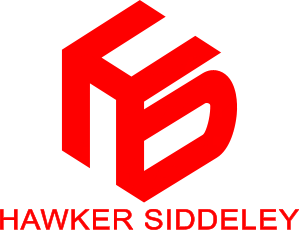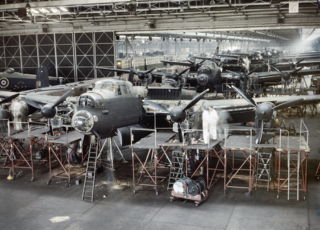
Vickers was a British engineering company that existed from 1828 until 1999. It was formed in Sheffield as a steel foundry by Edward Vickers and his father-in-law, and soon became famous for casting church bells. The company went public in 1867, acquired more businesses, and began branching out into military hardware and shipbuilding.
British Aerospace plc (BAe) was a British aircraft, munitions and defence-systems manufacturer that was formed in 1977. Its head office was at Warwick House in the Farnborough Aerospace Centre in Farnborough, Hampshire. It purchased Marconi Electronic Systems, the defence electronics and naval shipbuilding subsidiary of the General Electric Company, in 1999 to form BAE Systems.

The British Aircraft Corporation (BAC) was a British aircraft manufacturer formed from the government-pressured merger of English Electric Aviation Ltd., Vickers-Armstrongs (Aircraft), the Bristol Aeroplane Company and Hunting Aircraft in 1960. Bristol, English Electric and Vickers became "parents" of BAC with shareholdings of 20%, 40% and 40% respectively. BAC in turn acquired the share capital of their aviation interests and 70% of Hunting Aircraft several months later.
BAE Systems plc (BAE) is a British multinational arms, security and aerospace company, based in London, England. It is the biggest manufacturer in Britain as of 2017. It is the largest defence contractor in Europe and the seventh-largest in the world based on applicable 2021 revenues. Its largest operations are in the United Kingdom and in the United States, where its BAE Systems Inc. subsidiary is one of the six largest suppliers to the US Department of Defense. Its next biggest markets are Saudi Arabia, then Australia; other major markets include Canada, Japan, India, Turkey, Qatar, Oman and Sweden. The company was formed on 30 November 1999 by the £7.7 billion purchase of and merger with Marconi Electronic Systems (MES), the defence electronics and naval shipbuilding subsidiary of the General Electric Company plc (GEC), by British Aerospace, an aircraft, munitions and naval systems manufacturer.

Hawker Siddeley was a group of British manufacturing companies engaged in aircraft production. Hawker Siddeley combined the legacies of several British aircraft manufacturers, emerging through a series of mergers and acquisitions as one of only two such major British companies in the 1960s. In 1977, Hawker Siddeley became a founding component of the nationalised British Aerospace (BAe). Hawker Siddeley also operated in other industrial markets, such as locomotive building and diesel engine manufacture. The company was once a constituent of the FTSE 100 Index.

The British Aerospace 146 is a short-haul and regional airliner that was manufactured in the United Kingdom by British Aerospace, later part of BAE Systems. Production ran from 1983 until 2001. Avro International Aerospace manufactured an improved version known as the Avro RJ. Production for the Avro RJ version began in 1992. Later on, a further-improved version with new engines, the Avro RJX, was announced in 1997, but only two prototypes and one production aircraft were built before production ceased in 2001. With 387 aircraft produced, the Avro RJ/BAe 146 is the most successful British civil jet airliner program.
British Aerospace Dynamics Limited was a division of British Aerospace.

The British Aerospace 125 is a twinjet mid-size business jet. Originally developed by de Havilland and initially designated as the DH.125 Jet Dragon, it entered production as the Hawker Siddeley HS.125, which was the designation used until 1977. Later on, more recent variants of the type were marketed as the Hawker 800.
Airbus UK is a wholly owned subsidiary of Airbus which produces wings for Airbus aircraft. When Airbus was incorporated as a joint-stock company in 2001, BAE Systems transferred its UK Airbus facilities in return for a 20% share of the new company. These facilities became Airbus UK. The company has two main sites responsible for the design and manufacture of the high-technology wings for all Airbus models as well as overall design and supply of the fuel system. For most Airbus models, the company is responsible for overall design and supply of landing gear. The company employs around 13,000 people at two sites: Filton, where the engineering and design activity takes place along with some manufacturing, and Broughton, where other major wing component manufacturing and all wing assembly takes place.
Sir Richard Harry Evans, is a British businessperson who is chairman of the Kazakh state holding company Samruk-Kazyna. He is formerly chairman of the British arms manufacturer BAE Systems.

Woodford Aerodrome is a former airfield and aircraft factory at Woodford, Greater Manchester, England, 6 NM north of Macclesfield. It was opened by the Avro company after the First World War and became an important production centre for military aircraft in the Second World War. Notable planes made at the factory include the Avro Anson, Avro Lancaster, Avro Shackleton and Avro Vulcan.
John Pix Weston CBE FREng is a British businessman.
BAE Systems Military Air & Information is a business unit of British defence company BAE Systems responsible for the design, development, manufacture and support of fixed wing military aircraft. MAI customers include the Royal Air Force, Royal Saudi Air Force, US Navy and Indian Air Force.

The aerospace industry of the United Kingdom is the second-largest national aerospace industry in the world and the largest in Europe by turnover, with a global market share of 17% in 2019. In 2020, the industry employed 116,000 people.

Dunsfold Aerodrome is an unlicensed airfield in Surrey, England, near the village of Cranleigh. It extends across land in the villages of Dunsfold and Alfold.

ADS Group Limited, informally known as ADS, is the trade organisation representing the aerospace, defence, security and space industries in the United Kingdom. It has more than 1,000 member companies across its sectors, including some of the UK's largest manufacturers, like Airbus, Rolls-Royce, BAE Systems, Meggitt PLC and GKN.
John William Fozard, was a British aeronautical engineer who helped to design the Hawker Siddeley Harrier.

Jonathan Neale is a British businessman and the chief operating officer of McLaren Group. Neale's responsibilities as part of the executive management team include infrastructure development, information technology, facilities management as well as holding a number of statutory directorships.
Robert Edward Grigg was a British aerospace engineer, and was the chief designer of the highly-successful British Aerospace 146.
Today's Airbus SE is the product of international consolidation in the European aerospace industry tracing way before the formation of the Airbus Industrie GIE consortium in 1970. In 2000, the European Aeronautic Defence and Space Company (EADS) NV was established through the merger of Aerospatiale of France and DASA from Germany, and that subsequently bought Construcciones Aeronauticas from Spain. In addition to opther subsidiaries pertaining to security and space activities, EADS owned 100% of the pre-existing Eurocopter SA, established in 1992, as well as 80% of Airbus Industrie GIE. In 2001, Airbus Industrie GIE was reorganised as Airbus SAS, a simplified joint-stock company. In 2006, EADS acquired the remaining 20% shares of Airbus Industrie GIE from BAE Systems. EADS NV was renamed Airbus Group NV and SE in 2014, and 2015, respectively. Due to the commercial aircraft division's prominence within Airbus SE with it representing the largest part of the corporation's activities, Airbus S.A.S was published to be merged into the parent company in January 2017, but it was never done. Airbus SE remains therefore as the holding company for the commercial aircraft subsidiary Airbus SAS, while also being the parent company of the other two divisions Airbus Defence and Space and Airbus Helicopters. The company was given its present name in April 2018.









